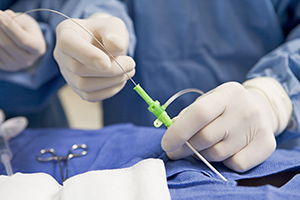Heart Failure: Procedures That May Help
The heart is a muscle that pumps oxygen-rich blood to all parts of the body. When you have heart failure, the heart isn't able to pump as well as it should. Blood and fluid may back up into the lungs (congestive heart failure). And some parts of the body don’t get enough oxygen-rich blood to work normally. These problems lead to the symptoms of heart failure.
Certain procedures may help the heart pump better in some cases of heart failure. Some procedures are done to treat health problems that may have caused the heart failure, such as coronary artery disease or heart rhythm problems. For more serious heart failure, other options are available.
Treating artery and valve problems

If you have coronary artery disease or heart valve disease, procedures may be done to improve blood flow. This helps the heart pump better, which can improve heart failure symptoms. First, your healthcare provider may do a cardiac catheterization to help find clogged blood vessels or valve damage. During this procedure, a thin tube (catheter) is inserted into a blood vessel in the leg (groin), arm, or neck. The tube is then guided to the heart. There a dye is injected and a special type of X-ray (angiogram) is taken of the blood vessels. Procedures to open a blocked artery or fix damaged valves can also be done using catheterization:
-
Angioplasty. This uses a balloon-tipped instrument at the end of the catheter. The balloon is inflated to widen the narrowed artery. In many cases, a metal mesh tube (stent) is expanded to further support the narrowed artery.
-
Valve repairs or replacements of faulty valves. These can also be done during catheterization. This helps blood to flow correctly through the chambers of the heart. Valve repairs or replacements may also be done surgically.
Bypass surgery is another option to help treat blocked arteries. It uses a healthy blood vessel from another part of the body. The healthy blood vessel is attached above and below the blocked area. This allows blood to flow around the blocked artery.
Treating heart rhythm problems
A device may be placed in the chest to help a weak heart maintain a healthy heartbeat so the heart can pump more effectively. In some cases, a wearable device may be advised.
-
Pacemaker. This is an implanted device that regulates your heartbeat electronically. It monitors your heart's rhythm and generates a painless electric impulse that helps the heart beat in a regular rhythm. A pacemaker is programmed to meet your specific heart rhythm needs.
-
Biventricular pacing/cardiac resynchronization therapy. This is a type of pacemaker that paces both pumping chambers of the heart at the same time. This helps to coordinate contractions and to improve the heart's function. Some people with heart failure are candidates for this therapy.
-
Implantable cardioverter defibrillator (ICD). This device is similar to a pacemaker. It senses when the heart is beating too fast. It then delivers an electrical shock to convert the fast rhythm to a normal rhythm. This can be a life-saving device.
-
Wearable cardioverter defibrillator (WCD). This is a vest worn on the chest with a defibrillator built into it. It senses when the heart is beating too fast. It then delivers an electrical shock to convert the fast rhythm to a normal rhythm. It's used for certain types of heart failure. It may be used if you can't have an ICD or while you're waiting for an ICD or heart transplant. It may also be used if you're at high risk for sudden cardiac death. Usually, a WCD is worn for several weeks or months. In some cases it may be used longer.
In severe cases
In more serious cases of heart failure when other treatments no longer work, other options may include:
-
Ventricular assist devices (VADs). These are mechanical devices used to take over the pumping function for 1 or both of the heart's ventricles, or pumping chambers. A VAD may be needed when heart failure progresses to the point that medicines and other treatments no longer help. In some cases, a VAD may be used as a bridge to a heart transplant.
-
Heart transplant. This is replacing the diseased heart with a healthy one from a donor. This is an option for a few people who are very sick. A heart transplant is very serious. It's not an option for everyone. Your healthcare provider can tell you more.
-
Ultrafiltration. This treatment mechanically removes excess fluid in the body. Ultrafiltration may be an option for people with certain types of heart failure who don't respond to other treatments, such as fluid-removing (diuretic) medicines.
Online Medical Reviewer:
Callie Tayrien RN MSN
Online Medical Reviewer:
Stacey Wojcik MBA BSN RN
Online Medical Reviewer:
Steven Kang MD
Date Last Reviewed:
10/1/2021
© 2000-2024 The StayWell Company, LLC. All rights reserved. This information is not intended as a substitute for professional medical care. Always follow your healthcare professional's instructions.